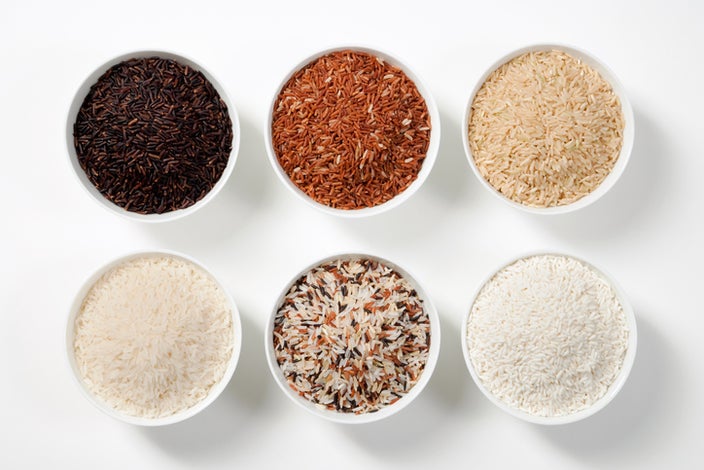
Brown Rice vs. White Rice: Comparing Their Nutritional Values
Key takeaways:
Brown rice is rich in nutrients and may help improve blood glucose levels and metabolic health.
White rice may support people with digestive issues and sensitive stomachs.
Brown rice is denser in nutrients than white rice, but both can provide health benefits as part of a balanced diet.
Table of contents

Rice is a popular food that’s rich in nutrients. But you’ve likely noticed that there are a range of rice options at the market, and their nutritional values vary. Some rice is enriched with nutrients, and grain sizes vary (long, medium, and short grain). Plus, rice comes in different colors. This leaves many wondering if brown rice or white rice is healthier for them.
Let’s sort through what research shows about the health benefits of rice in general and the specific benefits of white rice versus brown rice.
What are the differences between white and brown rice?
Besides how they look, there are many differences between white rice and brown rice. The way rice is milled (processed) plays a big role in these differences.
Save every month on GLP-1 meds with GoodRx
Save an average of $235 on FDA-approved GLP-1s like Ozempic and Zepbound.

Brown rice is the product of the first round of milling, which removes only the hull (a part of rice you can’t eat). This is rice in its intact form and includes the bran, germ, and endosperm. That’s why it’s also called whole-grain rice. Brown rice gets its name because of the natural color of the grain. Whole-grain rice also comes in colors like black, purple, and red.
White rice is the product of another round of milling, which takes off the bran and germ layers. Keep in mind that “white” doesn’t refer to a type or variety of rice — it’s the color the rice takes after milling and polishing. And because white rice goes through these extra processing steps, it loses nutrients. That’s why you’ll often see white rice sold as “enriched.” That means vitamins are added back in after processing.
These differences in processing also affect how the rice cooks. White rice cooks faster than brown rice because it has fewer layers and less fiber. You’ll need to cook whole-grain brown rice for longer, and it’ll still be chewier than white rice.
Is brown rice or white rice healthier?
The short answer is that brown rice is a more nutrient-dense product than white rice. But both can be nutritious parts of a well-balanced diet. All the same, it’s a bit more complex than that — especially if you have any underlying digestive issues.
To help digestion, certain people need to eat foods that are lower in residue or fiber. In these cases, white rice is the better choice. This applies if you recently had bowel surgery or have an inflammatory bowel disease (IBD), like Crohn’s disease or ulcerative colitis.
But, for most people, complex carbohydrates — like brown rice — are healthier because they’re rich in nutrients and fiber, and lower on the glycemic index.
Read more like this
Explore these related articles, suggested for readers like you.
For example, some research shows that brown rice may help support weight management in certain populations. But more research is needed to understand the effect of whole grains on weight.
Other research suggests that when you replace brown rice with white rice in the diet, you may help reduce the risk of developing Type 2 diabetes. Another study found that eating brown rice may help reduce hemoglobin A1C (HbA1c or A1C) in people with metabolic syndrome and a high body mass index (BMI).
Brown rice vs. white rice: Nutritional value
When you look at nutrition facts, there’s no denying that brown rice is more nutrient-dense than white rice. Brown rice contains a variety of B vitamins, vitamin E, iron, and phytochemicals. With white rice, B vitamins and iron are often added back in after the milling process.
Here’s a side-by-side comparison of medium-grain, cooked brown rice versus medium-grain, enriched and cooked white rice.
White rice (1 cup) | Brown rice (1 cup) | |
|---|---|---|
Calories | 242 g | 218 g |
Carbohydrates | 53.2 g | 45.8 g |
Protein | 4.43 g | 4.52 g |
Fat | 0.391 | 1.62 g |
Dietary fiber | 0.558 | 3.51 g |
Phosphorus | 68.8 mg | 150 mg |
Thiamine | 0.311 mg | 0.199 mg |
Niacin | 3.42 mg | 2.59 mg |
Vitamin B6 | 0.093 mg | 0.291 mg |
Magnesium | 24.2 mg | 85.8 mg |
Copper | 0.071 mg | 0.158 mg |
Manganese | 0.071 mg | 2.14 mg |
Iron | 2.77 mg | 1.03 mg |
Source: USDA
What are some other healthy grains?
Besides whole-grain rice, there are other nutritious grains, including:
Barley
Millet
Rye
Oats and oatmeal
Corn or popcorn
Grain substitutes
If you’re sensitive to grains, there are also nutritious, grain-free substitutes, such as buckwheat or quinoa.
Quinoa has a similar texture to whole-grain rice and is a rich source of fiber and protein. Buckwheat is a gluten-free grain substitute that you can eat as a porridge-style dish, add to soups or salads, or use in its flour form in recipes for pancakes and bread.
Is rice better than other carbs like pasta?
One study of people with Type 1 diabetes showed that pasta led to lower peak blood sugar levels after a meal than white rice. This is likely because the 1 cup of standard cooked pasta contains 2.5 g of fiber and 8 g of protein. This is significantly more fiber and protein than 1 cup of cooked white rice. And protein and fiber can help to stabilize blood sugar levels.
But keep in mind that a balanced diet includes more than just one type of food. So the questions of brown rice versus white rice and rice versus pasta really only tell you one piece of a larger puzzle.
The bottom line
Brown rice is a more nutrient-dense product than white rice. Because of this, brown rice may help reduce blood sugar levels and aid in managing weight. But white rice is good for people with certain digestive issues and those who can’t digest fiber-rich foods well. Although brown rice has more nutritional value, both brown and white rice in moderation can fit well in a nutritious and balanced diet.
Why trust our experts?


References
Economic Research Service. (2023). Rice sector at a glance. U.S. Department of Agriculture.
FoodData Central. (2019). Buckwheat groats, roasted, cooked. U.S. Department of Agriculture.
FoodData Central. (2019). Quinoa, cooked. U.S. Department of Agriculture.
FoodData Central. (2019). Rice, brown, medium-grain, cooked (Includes foods for USDA's Food Distribution Program). U.S. Department of Agriculture.
FoodData Central. (2019). Rice, white, medium-grain, enriched, cooked. U.S. Department of Agriculture.
Malik, V. S., et al. (2019). Substituting brown rice for white rice on diabetes risk factors in India: A randomised controlled trial. The British Journal of Nutrition.
Maki, K. C., et al. (2019). The relationship between whole grain intake and body weight: Results of meta-analyses of observational studies and randomized controlled trials. Nutrients.
MedlinePlus. (2022). Low-fiber diet.
MyPlate. (n.d.). Grains. U.S. Department of Agriculture.
Peña-Rosas, J. P., et al. (2019). Fortification of rice with vitamins and minerals for addressing micronutrient malnutrition. Cochrane Database of Systematic Reviews.
Ravichanthiran, K., et al. (2018). Phytochemical profile of brown rice and its nutrigenomic implications. Antioxidants.
Sawada, K., et al. (2019). Relationship between rice consumption and body weight gain in Japanese workers: White versus brown rice/multigrain rice. Applied Physiology, Nutrition, and Metabolism.
Sun, Q., et al. (2010). White rice, brown rice, and risk of type 2 diabetes in US men and women. Archives of Internal Medicine.
Trinidad, T. P., et al. (2009). Iron absorption from brown rice/brown rice-based meal and milled rice/milled rice-based meal. International Journal of Food Sciences and Nutrition.
Vidueiros, S. M., et al. (2015). Diversity and interrelationships in nutritional traits in cultivated quinoa (Chenopodium quinoa Willd.) from northwest Argentina. Journal of Cereal Science.
Zavitsanou, S., et al. (2019). The effect of two types of pasta versus white rice on postprandial blood glucose levels in adults with type 1 diabetes: A randomized crossover trial. Diabetes Technology & Therapeutics.





























